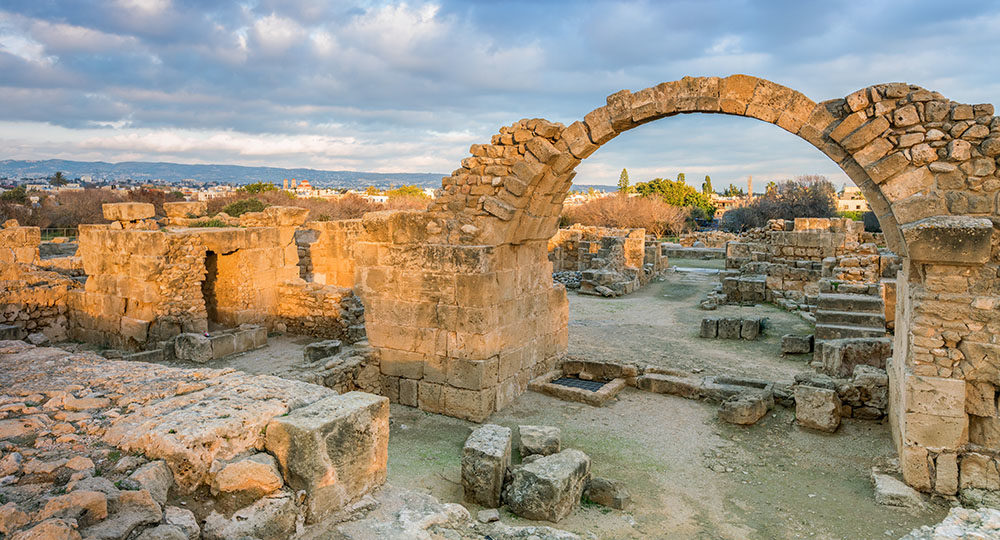Prince of Heresy: The Mystery of Simon of Samaria
Authors always seem quick to entice readers with the promise of revealing the real truth behind some Bible “mystery.” When I last checked Amazon.com for books with both the words mystery and Bible in the titles, I found no fewer than 1,959. Many, I presume, are simply wild speculations by those who lack serious belief in Scripture’s inerrancy and divine inspiration.
With that prologue, however, let me say that there is a true mystery in Acts 8. While Philip the evangelist preached the gospel throughout Samaria, he met a man named Simon, a magician whose dark practice of the magical arts had astonished many and gained him a wide audience. When Philip preached Jesus Christ, Simon’s followers left him, believed in the Savior, and began to be baptized. Luke, the human author of Acts, noted, “Then Simon himself also believed; and when he was baptized he continued with Philip” (v. 13).
But the story doesn’t end there.
After noticing the apostles’ powerful, supernatural ability to bestow the Holy Spirit on believers in Samaria through the laying-on of hands, Simon began to lust after the same power (vv. 18–19).1 When he tried to purchase it from the apostle Peter, he earned one of the most severe rebukes found in the New Testament (vv. 20–23). Scripture’s portrait of Simon ends with him begging Peter to pray to the Lord on his behalf, hoping to escape the consequences of the condemnation Peter levied against him (v. 24).
So here is the mystery: Was this former sorcerer a true believer in Christ, and what became of him after verse 24?
The answer to these questions is more than mere Bible trivia. It is a key to understanding the dangers of heresy and false spirituality that plague 21st-century popular culture and that have infected current ultraliberal Bible “scholarship.”
The Rise and Fall of Simon Magus
History records that this same Simon surfaced years later as “Simon Magus,” a heretical cult leader who appeared during the development of the early church and founded a competing pseudo-Christian sect. The early church fathers who wrote in defense of the true gospel after the apostles’ deaths and sometimes were martyred for it, wrote extensively about Simon Magus.
Irenaeus attributed the rise of heretical Gnosticism to Simon, whom he described as a propagator of false knowledge. (Gnosticism emphasized the esoteric attaining of “secret knowledge” of God.) Justin Martyr condemned Simon’s teachings, and Hippolytus related that Simon had created an extensive Gnostic philosophy and tried to mimic Christ’s resurrection by having himself buried alive with the promise of being raised three days later. However, things ended poorly—and finally—for him when the “miracle” failed.2
The early church fathers quoted extensively from ancient, heretical religious writings that were rife with mention of Simon Magus: the second-century apocryphal book The Great Exposition, supposedly written by Simon (though more likely by his disciples), and the third-century apocryphal Acts of Peter and Pseudo-Clementine literature. The Great Exposition spoke openly about Simon’s status as a pretender-redeemer; the others show Simon as Peter’s archrival, fighting with him to the death in Rome where Peter supposedly foiled Simon’s attempt to fly in the air by sending him crashing down to the earth.3
Gnosticism as a heretical sect slowly faded, but the significance of Simon as a progenitor of false spirituality lived on for nearly two millennia through depictions in art and culture. Michelangelo drew a sketch of Simon’s mythical battle with Peter; 17th-century artist Avanzino Nucci painted a scene depicting Peter’s disputation with Simon; and numerous other artists used Simon Magus as a subject, with Simon even appearing in the architectural features of cathedrals. Dante’s The Divine Comedy mentions Simon in Canto XIX in his section on the interiors of hell:
Woe to thee, Simon Magus! Woe to you, his wretched followers! Who the things of God, which should be wedded unto goodness, them, rapacious as ye are, do prostitute for gold and silver in adultery.
The Rise of Skepticism
But then something happened with the approach of the 20th century. Simon Magus, who had been viewed for almost 2,000 years as a paragon of heresy, was given a kind of historical pass. Typical of liberal church histories that began to doubt his real influence is this one:
Theories [of the church fathers] about the origins and sources of Gnosticism (which they liked to trace back through a succession of teachers to Simon Magus, as portrayed in the narrative of Acts 8:9–24) were mostly produced to serve the needs of their polemic…their understanding and handling of Gnostic ideas could be biased and unsympathetic even when their reporting was faithful.4
Notice that the motives of the Fathers are cast in doubt, not the accuracy of their writings concerning Simon Magus. The same several theologians and church historians quoted above (from Union Theological Seminary, a bastion of liberal religious thought) also reluctantly admitted, “The sources these writers use [often are] trustworth[y] and their reporting [is] accurate.”5
Another reason for the decline in Simon’s status as a heretic arises from the fact that the very concept of heresy has fallen out of fashion. Heresy (false doctrine) implies there is true doctrine. But liberal scholarship has attempted to reduce doctrinal creeds and the fundamentals of the faith to total irrelevancy.
Self-professed liberal John Shelby Spong has boldly pronounced that Christians must face “a devastating realization—namely, that the primary creedal doctrines of the Christian faith were built to address a human condition that is simply not true.”6 Robert Funk, founder of the ultraliberal Jesus Seminar, wrote that the rise of “heretics” really began only when dissenting bishops refused to subscribe to official “orthodoxy” at the Council at Nicea in 325.7 For some reason, Mr. Funk, who admits the Apostles’ Creed may be as old as the second century,8 doesn’t see the irony in that timing: The Creed—which predated Constantine’s Nicaean Council by more than 100 years—was created to codify the fundamental beliefs of the early church and to distinguish them from the heresies that threatened to distort the historical truth about Jesus and the true message of the gospel.
Funk’s last distortion (we might call it a historical “heresy”) has been mirrored in Dan Brown’s wildly popular and famously inaccurate novel, The Da Vinci Code. One of the book’s characters proclaims, “The early Church literally stole Jesus from His original followers, hijacking His human message, shrouding it in an impenetrable cloak of divinity, and using it to expand their own power.” Even more to the point: “Constantine commissioned and financed a new Bible, which omitted those [Gnostic] gospels that spoke of Jesus’ human traits and embellished those gospels that made Him godlike.”9
It is no wonder that popular thought in the 20th and 21st centuries should forget the moral behind the story of Simon, the sorcerer from Samaria. When the possibility of objective theological truth is doubted and history is rewritten with an antibiblical bias, the idea of doctrinal truth becomes archaic—an outdated curiosity.
The Sorcerer’s Reemergence
At the same time liberal scholarship was attempting to make Simon Magus irrelevant, a new phenomenon was arising that openly celebrated his heretical influence. In 1875 Helena Blavatsky launched a new movement called “theosophy”; and the Theosophical Society was established, which contended that one can only know God through mysticism.10 The movement’s tenets bore a powerful resemblance to the ancient teachings of the Gnostics and to the philosophy of Simon Magus in particular. G. R. S. Mead, a leading theosophist in the early 20th century, wrote,
The present revival of theosophical enquiry throws a flood of light on Simon’s teachings, whenever we can get anything approaching a first-hand statement of them, and shows that it was identical in its fundamentals with the Esoteric Philosophy of all the great religions of the world.11
While theosophy as a formal movement died out, its Gnostic roots remain; and they continue to energize and inform the religions of the New Age movement.12 The worldwide success of The Da Vinci Code and the more recent publicity regarding the so-called “Gospel of Judas,” a Gnostic text spotlighted by National Geographic, are evidence that the fraudulent doctrines of Simon Magus and his ilk, long thought to be dead, are now prowling the halls of religious academia and parading in the streets of popular culture.
Why Truth Matters
Despite the appearance of conversion, was Simon of Samaria really a closet heretic with corrupt motives that he kept concealed until after his dramatic interchange with Peter in Acts 8:18–24?
The historical facts strongly support that conclusion. And more than one Bible commentator, including F. F. Bruce, has doubted the sincerity of Simon’s profession of faith.13 In fact, some important clues in the biblical text help us conclude that Simon’s profession of faith was not sincere. His “conversion” came only after he began to lose his audience to Philip (Acts 8:11–12). We are told that Peter and John laid hands on the Samaritan believers to impart the Holy Spirit (v. 17); yet Simon, who had been referenced by name in verses 10–13, is not named as one who received the Holy Spirit.
More important, Simon’s actions evidenced the rotten fruit of an unregenerate heart. Peter accused him of “wickedness” and being “poisoned by bitterness and bound by iniquity” (vv. 22–23). Further, when Peter instructed Simon to repent and pray for forgiveness, Simon failed to do so. Instead, he begged Peter, “Pray to the Lord for me, that none of the things which you have spoken may come upon me” (v. 24). Simon’s lips do not reveal heartfelt repentance, merely a desire to avoid judgment.
The text of Acts 8, coupled with the early Fathers’ outrage concerning Simon, whom they considered the prince of heresy, lead us to conclude that Simon’s heart never left the pagan tendencies of a sorcerer. After his superficial brush with Christianity, he merely adapted his corrupt philosophy to feed off the newly forming church of Jesus Christ, as a parasite feeds off its host. Gnosticism, which used the name of Christ but exalted the false idea of achieving divinity through secret knowledge, suited his predilection toward the mysterious, esoteric dark arts.
Such false professions of faith are not unique in the biblical record. In Genesis, Cain’s sacrifice had the appearance of obedience; but it concealed a corrupt heart and a self-willed approach to God. In the New Testament Gospels, Judas walked daily with Jesus’ disciples, and they apparently had no inkling he was a traitor and spiritual imposter.
The proliferation of cults, spiritual gurus, and false religions is a constant challenge to the church. Yet the lesson of Simon Magus is clear: False prophets and teachers are the most dangerous when they appear to follow familiar practices and Christian traditions, while still holding ideas that are antithetical to Scripture. We are warned, “Do not believe every spirit, but test the spirits, whether they are of God; because many false prophets have gone out into the world” (1 Jn. 4:1).
But there is yet another reason to heed the lesson of Simon the Samaritan. The Lord admonishes us to cling diligently to that which is true: “Grace and truth came through Jesus Christ” (Jn. 1:17). Let us discern the truth and practice it and cling to Jesus, the One who came to save us.
ENDNOTES
- Charles Ryrie explains that God generally bestowed the Holy Spirit at the moment of faith in Christ; however, in the case of the Samaritans, the Lord chose the apostles from Jerusalem as the vehicle for transmission of the Holy Spirit. The method acted as a unifying bond and helped ensure there would be no separate, rival Samaritan Christian sect. The Ryrie Study Bible (Chicago: Moody Press, 1978) 1658, n. Acts 8:14–17.
- F. Bruce, Commentary on the Book of Acts (Grand Rapids: Eerdmans, 1981), 178 nn. 28, 29.
- Kurt Rudolf, Gnosis: The Nature and History of Gnosticism (Edinburgh: HarperCollins, 1987), 294–297.
- Williston Walker, Richard A. Norris, David Lotz, and Robert T. Handy, A History of the Christian Church, 4th ed. (New York: Scribner, 1985), 62.
- Ibid.
- John Shelby Spong, A New Christianity for a New World (San Francisco: HarperCollins, 2001), 124–125.
- Robert W. Funk, Honest to Jesus: Jesus for a New Millennium (New York: HarperCollins, 1996), 37.
- Ibid, 43.
- Dan Brown, The Da Vinci Code (New York: Doubleday, 2003), 233–234.
- Encyclopædia Britannica, 2006 CD, s.v. “Helena Blavatsky.”
- R. S. Mead, “Simon Magus: An Essay on the Founder of Simonianism Based on the Ancient Sources With a Re-Evaluation of His Philosophy and Teachings,” The Project Gutenberg EBook of Simon Magus <gutenberg.org/files/12892/12892-h/12892-h.htm>.
- C. Campbell-Jack, Gavin J. McGrath, eds., New Dictionary of Christian Apologetics (Leicester, England: InterVarsity Press, 2006), 288.
- Bruce, 183–184.







Thankful for the insight of this article. I had always accepted that Simon truly repented. However, these “new” facts point me to an entirely different conclusion and I think a better and more correct one
Dear Mr Parshall
Is is possible Simon Magus (of Samaria) was Jesus Barabbas the second Christ?
Yours sincerely
Mark Scully
Canberra
ACT
Australia